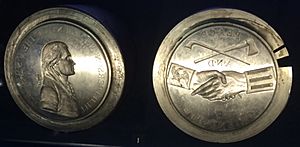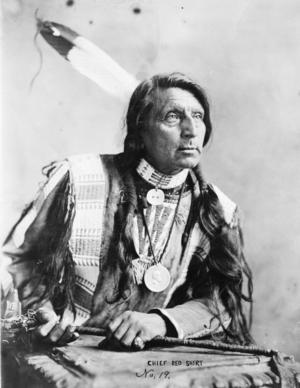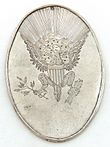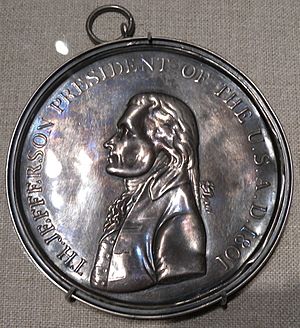Indian peace medal facts for kids

Indian peace medals were special round or oval medals given to Native American leaders. They were used during the time when Europeans were colonizing America and later by the early United States. Most of these medals were made of silver or brass. They ranged in size from about one to six inches across. People often wore them around their necks.
Some people still debate how much these medals truly helped build good relationships between Native Americans and the government. Today, many Indian peace medals are kept safe in museums, libraries, and cultural centers.
Contents
Early Peace Medals and Their Purpose
The first peace medals appeared when European countries started settling in America. This was as early as the 1600s. European nations like the British, French, and Spanish gave these medals to Native American tribes. They wanted to create friendships and make agreements. Often, they also gave national flags and other gifts.
Some silver medals from the 1700s have been found in Pennsylvania. These medals show a Native American offering a peace pipe to a Quaker. European countries also used medals to get help from tribes during wars. For Native Americans, these early medals meant a promise of trade. They would receive items like kettles, beads, clothes, and weapons. In return, they would provide animal hides, furs, and feathers. These raw materials were very important for European trade.
The earliest peace medals from the US government might be from 1789. This was the year George Washington became president. These medals show a Native American man dropping his tomahawk. He is also receiving a peace pipe from a figure representing America. On the back, there is an eagle and thirteen stars. Medals from 1792 to 1795 were similar. But they showed George Washington instead of the figure of America.
These medals were a way for the United States to show its promise. They wanted to build peace and good relationships with the Native Americans. Giving out medals often happened during a formal treaty or negotiation. One of the first times the US government used them was during the Treaty of Hopewell in 1785. This treaty was with the Cherokee nation.
No one knows exactly where the idea for Indian peace medals came from. Even Thomas Jefferson said that using these medals was "an ancient custom from time immemorial."
Presidential Peace Medals
Early peace medals showed both European and Native American figures. But after Thomas Jefferson became president in 1801, the medals changed. They almost always showed the face of the current president. Jefferson's medals were the first of this kind. They started a long series of presidential medals that continued until Benjamin Harrison's presidency (1889 – 1893). These presidential medals were made in large numbers using special molds. This was different from making each medal by hand.

The first Jefferson medals were made in 1801. One side showed a picture of Thomas Jefferson. The other side showed the clasped hands of a Native American and a US soldier. Above the hands, there was a tomahawk and a peace pipe. The words "Peace and Friendship" were also there. Above Jefferson's face, it said his name, title, and the year 1801. Jefferson medals were made of two thin silver discs joined by a silver rim. They had a wooden core inside. They came in three sizes: 55mm, 75mm, and 105mm wide.
How the US Government Used Presidential Medals
The US government gave out presidential medals during almost every important meeting with Native Americans. This practice was so common that Thomas L. McKenney, who was in charge of Native American affairs, wrote in 1829: "Without medals, any plan of operating among the Indians... is essentially enfeebled." This means he thought medals were very important for working with Native Americans.
Because peace medals were so popular, rules were made about who received them. Presidential medals were given to specific important individuals. For example, in 1908, a Senate group suggested giving medals to Native American police officers. These officers had arrested Sitting Bull, a Sioux chief, in 1890.
Meriwether Lewis and William Clark famously gave out about 87 peace medals. Many of these were Jefferson medals. They gave them to Native American leaders during their 1803-1806 expedition. This was a way to show the government's good intentions.
In 1829, Lewis Cass and William Clark suggested rules for giving out medals. These rules were never officially adopted. But they show how medals were usually given. The largest medals were for the main chiefs. Mid-sized medals went to war chiefs. The smallest medals were for less important chiefs and warriors. Giving out medals required special ceremonies. If someone wore a foreign medal, it would be replaced with an American one if they deserved it.

Native American Views on Peace Medals
Native Americans valued the peace medals greatly. They were often buried with the owner or passed down through families. Many portraits of Native American leaders show them wearing these medals around their necks. This proves how important the medals were to them.
Peace medals became similar to earlier worn shell gorgets in Native American beliefs. Wearing a medal connected the person to the image on it. This could be a king or a president. The images on the medals symbolized access to the "White man's world." This world brought new trade goods and technologies, like rifles. The medals became a physical sign of a spiritual connection. They linked the wearer to a source of power, like the "Great Father," a name used for President Washington. Giving out peace medals also helped strengthen the political order within the tribes.
Criticisms of Peace Medals
Not all Native American leaders liked the US peace medals. Black Hawk, a Sauk chief, was one of them. He wrote in his autobiography, "Life of Ma-Ka-Tai-Me-She-Kia-Kiak" (1833), that he never wore a US peace medal. However, he openly wore medals given to him by the British, especially during the War of 1812. Black Hawk wrote, "Whilst the British made but few [promises]- we could always rely upon their word." He felt that US promises were not reliable. He compared US coins and medals, saying both were "very hand-some," but also unreliable.
Other people have also criticized Indian peace medals. They question what "peacekeeping" truly meant and for whom. Art historian Klaus Lubbers studied US peace medals from 1789 to 1889. He noticed how the medal designs changed. These changes showed the government's policy of trying to make Native Americans live like White settlers.
The first peace medals showed full Native American figures with simple backgrounds. Later medals started to include farm scenes with houses, oxen, and farmland. Over time, the Native American figures became smaller in the designs. Lubbers believed this showed a decrease in equality between White people and Native Americans. For example, the Rutherford B. Hayes medal from 1877 was made when the government was pushing for the Indian Removal Act. This law forced Native Americans to move from their lands. The Hayes medal showed very little space for the Native American figure. The background showed a White man leaning on an ax with a chopped tree. Behind him, there was a log cabin with a woman and baby, and a man plowing. This showed the world of the White settler.
Indian Peace Medals Today
By the 1840s, Indian peace medals became known as a "presidential series." People became very interested in collecting them. The federal mint in Philadelphia started collecting the original molds for the medals. This led to making bronze copies of the medals. These copies were given to government officials or historical groups.
The production of bronze medals began in 1842 with the Jefferson medal. However, the molds for the Washington and John Adams medals were missing at first. The John Adams mold was found in 1878. The George Washington mold was finally remade in 1903. This completed the series.
The American Numismatic Society in New York has the largest collection of Indian peace medals. They have almost every medal ever made. The Smithsonian Institution in Washington, D.C., also has a very large collection. Other important collections can be found at the Denver Natural History Museum, the Gilcrease Institute of American History and Art, the Henry Ford Museum, and the Massachusetts Historical Society. Smaller collections are held by places like the Arizona Pioneer's Historical Society, Boston Museum of Fine Arts, Brooklyn Museum, and the Chicago Historical Society. Many peace medals are also owned by private collectors.




